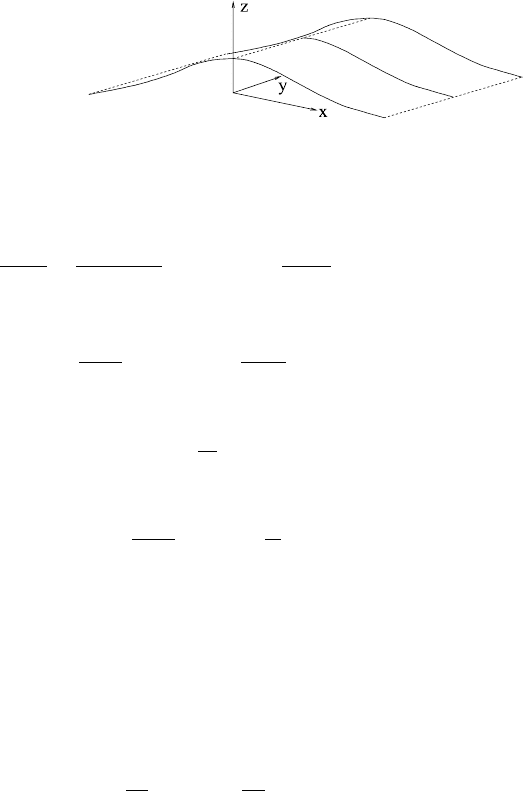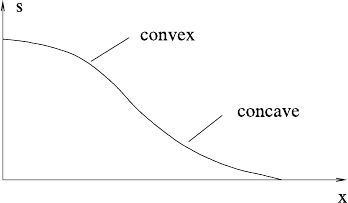Fowler A. Mathematical Geoscience
Подождите немного. Документ загружается.


340 6 Landscape Evolution
these approximations, η ≈s, we apparently do not need to specify A, and the model
reduces to
∇.(hu) =r,
|u|u =−h∇η,
η
t
=−∇.[f N]+U,
(6.25)
where N is given by (6.22). Putting δ =0, we get
τ
e
≈−(h +β)∇η. (6.26)
Solving for u and substituting into the water mass equation, we can write the
system (6.25) in the form introduced by Smith and Bretherton:
∇.[qn]=r,
η
t
=−∇.[f n]+U,
n =−
∇η
|∇η|
,
(6.27)
where the water flux is
q =h|u|=h
3/2
S
1/2
, (6.28)
the effective stress is
τ
e
=(qS)
2/3
+βS, (6.29)
and the magnitude of the slope is
S =|∇η|. (6.30)
The dimensionless Meyer-Peter/Müller relationship, for example, can be written in
the form
f =
(qS)
2/3
+βS −τ
∗
c
3/2
+
, (6.31)
where the dimensionless critical stress is given, using (6.13) and (6.18), by
τ
∗
c
=
μ
c
ρ
sw
ρ
w
D
s
[h]
l
d
. (6.32)
Using estimates μ
c
= 0.05, ρ
sw
/ρ
w
= 2, D
s
= 1 mm, [h]=2cm,l = 10
5
m,
d =10
3
m, we have τ
∗
c
≈0.5. We see that (6.27) forms a pair of equations for η and
q; the equation for η is essentially parabolic, while that for q is hyperbolic, although
the coupling between the equations confuses the situation.
6.5.1 Boundary Conditions
The approximation δ →0 which takes us from (6.20)to(6.27) is in fact a singular
one. This can be seen through the fact that the approximation of N by n involves the
loss of a term proportional to δ∇h, so that a Laplacian term in h (or equivalently, q)

6.5 Channel-Forming Instability 341
is missing from (6.27)
2
. This suggests that we ought to prescribe two conditions on
the boundary of the domain. If we consider the uplift of an island continent D with
prescribed boundary ∂D, then the natural conditions to apply are
η =0 and
∂η
∂n
=0on∂D. (6.33)
These represent the idea that the position of the coastline is known, and that the
water surface gradient becomes equal to the ocean gradient (zero) at the coastline.
The loss of the parameter δ precludes us from applying the second boundary
condition in (6.33), and in order to do so, we would require a boundary layer of
thickness δ at the boundary, over which h will change rapidly in order to satisfy
(6.33)
2
. This is a passive boundary layer and of little consequence. The reduced
equation (6.27)
1
with δ = 0 is then hyperbolic, and the natural boundary condition
on the resulting sub-characteristics is to prescribe q at their upstream end. These
occur at summits where |∇s|=0, and we expect q = 0 there, but since the q equa-
tion appears to be degenerate at the summit (∇s/|∇s| is undefined), it is not entirely
obvious whether it is necessary to prescribe q at all. A similar situation applies for
a two-dimensional ridge, if the slope is smooth.
A further complication is that it can be expected that the bedload transport func-
tion f(S,q)→ 0 as both S and q → 0. In particular, since we expect q → 0ata
ridge, this suggests that the diffusion equation (6.27)
2
for s is degenerate, so that
smoothness may be lost at a ridge, and ∇s may be discontinuous there. In particu-
lar, it is not obvious that S →0 at a ridge. The best that can definitely be said is that
the downslope component of both water flux and sediment flux should tend to zero
at a ridge or a summit.
6.5.2 Steady State Solution
Our purpose is to study conditions under which uniform overland flow is unstable,
and the simplest situation in which we can do this is when the basic steady state flow
is one-dimensional. Therefore we consider a basic state consisting of a symmetric
hillslope inclining down towards a fixed boundary, as indicated in Fig. 6.3.Wetake
the divide to be at x =0 and the margin at x =1, and we solve the one-dimensional
version of (6.27)inx>0, assuming that η
x
< 0, thus −∇η/|∇η |=i, where i is the
unit vector in the x-direction:
∂q
∂x
=r,
∂f
∂x
=U, (6.34)
and the solution with zero fluxes at the ridge is
q =rx, f =Ux. (6.35)
More generally,
q =R =
x
0
rdx, f =W =
x
0
Udx, (6.36)

342 6 Landscape Evolution
Fig. 6.3 One-dimensional
hillslope geometry
if we suppose rainfall r and uplift U to be functions of the distance x from the
divide. If we take the Meyer-Peter/Müller transport law (6.31), for example (but
written in terms of h and S =−η
(x), then we find that h and η are given by
h
3
h +β
=
R
2
τ
∗
c
+W
2/3
,η=
1
x
R
2
dx
h
3
. (6.37)
If τ
∗
c
and β are small and can be ignored, these are simply
h ≈
R
W
1/3
,η≈
1
x
Wdx
R
, (6.38)
and the slope is
S =
W
R
. (6.39)
The particular choices of constant uplift and rainfall then give
h ≈
rx
2/3
U
2/3
,S=
U
r
, (6.40)
and the slope is constant. Note that in this case the hillslope is not zero at the divide,
and this is generally true if the yield stress is non-zero, since the sediment transport
is positive for all x>0.
A crucial feature of the hillslope for stability purposes is the sign of the slope cur-
vature, or the sign of S
. The shape of the hillslope depends on the bedload transport
function f(S,q), and in general must be found numerically. For constant rainfall
and uplift, the sign of the curvature can be ascertained analytically, however. Differ-
entiating f with respect to x, we find (using (6.35)),
x
∂f
∂S
S
=f −q
∂f
∂q
. (6.41)
Supposing always that ∂f /∂ S > 0, we have S
> 0 if and only if f −q∂f/∂q > 0.
We define concavity and convexity of hillslopes as shown in Fig. 6.4, thus convex
slopes have S
< 0, concave ones have S
> 0. Thus convexity or concavity of a
hillslope is determined only by the dependence of the bedload transport on water
flux, in conditions of constant rainfall and uplift.
In particular, and absolutely confusingly, functions which are mathematically
convex, so that, in particular, ∂f /∂ q > f /q everywhere, lead to (geomorpholog-
ically) concave hillslopes, and vice versa. Worse, a mathematician would call
the ‘concave’ portion of the graph in Fig. 6.4 convex. Worse still, the criterion
∂f /∂ q > f /q is satisfied by mathematically convex functions, but not all such func-
tions are mathematically convex everywhere. It is best to forget the mathematical

6.5 Channel-Forming Instability 343
Fig. 6.4 Convexity and
concavity
definitions; geomorphologically concave transport laws lead to similarly shaped
hillslopes.
It is fairly evident that convex or concave hillslopes can be formed independently
of f , if rainfall or uplift are spatially varying. For example, the Meyer-Peter/Müller
law with β =τ
∗
c
=0issimplyf =qS, so that f
q
=f/q, and the slope is constant
(as we found) for constant r and U . When they vary, S =W/R, and by appropriate
choice of r and U , we may have S
being positive or negative in different regions.
6.5.3 Uplift and Denudation
Before we begin our stability analysis of the purely x-dependent state, we should
put our model into a physical context. We pose a constant (or perhaps spatially de-
pendent) rate of uplift and purely fluvial erosion mainly in order to establish a clean
mathematical problem. In reality, orogenic episodes are more likely to occur in tran-
sient events. For example India runs into Asia some 50 million years ago, and starts
building the Himalayas, a process which is still continuing. So while our model
might apply in the early phases of the orogeny, there is certainly never a steady
state, and the fluvial drainage systems which no doubt grew in the early phases of
the orogeny did so as instabilities formed on a slowly evolving uplifting topography.
Thus, while we emphasise the instability of a steady state as a mathematically pre-
cise way of analysing the problem, this is not really the ‘right’ problem. Equally and
more obviously, fluvial erosion becomes irrelevant at greater topographic heights,
when glacial erosion and landslides become the erosive mechanisms of choice.
As regards instability, this issue is not a real barrier to understanding, because
instability, when it occurs, does so rapidly, so that to all intents and purposes we
can still do stability analysis even when the background hillslope topography is
changing slowly. In that case, the form of the topography is determined essentially
by tectonic processes, and not by the model proposed here. For example we might
suppose that tectonic compression could form a series of sinusoidal folds transverse
to the direction of compression; such folds are unstable to channel formation in their
valleys, as indeed we would expect.

344 6 Landscape Evolution
6.5.4 Geomorphically Concave Slopes are Unstable
We study the linear stability of the one-dimensional steady state (6.35) of the gov-
erning equations (6.27). We denote the steady state with a subscript zero, and will
focus on the region x>0, where the slope η
0
< 0; to extend the discussion to the
other side of the hillslope, we simply note that the basic solutions for q and f there
are even extensions of those in (6.35). Unless otherwise stated, we will assume that
r and U are constant.
Denoting perturbations by an overtilde, thus
η =η
0
+˜η, (6.42)
and so on, we find
∇η =η
0
i +∇˜η,
S =|∇η|=S
0
−˜η
x
...,
(6.43)
where S
0
=−η
0
. From these, it follows that the downslope unit vector is
n =i −
˜η
y
S
0
j +···, (6.44)
where j is the unit vector in the transverse y direction.
This gives the linear approximation for n. If we perturb f and q by quantities
˜
f
and ˜q, then we obtain, on linearising the equations,
∂ ˜q
∂x
=
q
S
∂
2
˜η
∂y
2
,
∂ ˜η
∂t
=
∂
∂x
f
S
∂ ˜η
∂x
−f
q
˜q +
q
S
f
q
−f
q
∂
2
˜η
∂y
2
,
(6.45)
where f
S
= ∂f /∂ S , f
q
= ∂f /∂ q , and f
q
denotes the x derivative of f
q
, all these
quantities being evaluated in the basic steady state (we omit the subscripts zero for
convenience).
It is worth pausing with these linearised equations. We see in the second that it
is of diffusive type, but that the apparent diffusion coefficient in the y direction can
be negative, and is so if f
q
>f/q; returning to (6.41), we see that this condition is
met precisely if the steady hillslope is geomorphologically concave (when r and U
are constant).
Such an assessment might seem premature, since the term in ˜q is coupled (via
(6.45)
1
) to another ˜η
yy
term. But as we shall see, it is essentially accurate; as an
example, if the bedload transport function is taken as f ∝ q
n
for some positive
exponent n, then f
q
=0, and the conclusion above is precise.
We use normal mode analysis, and write ˜η and ˜q in the form
˜q =φ(x)e
iky+σt
, ˜η =ψ(x)e
iky+σt
; (6.46)

6.5 Channel-Forming Instability 345
from these definitions it follows that
φ
=−
k
2
qψ
S
,
σψ =[f
S
ψ
]
−(f
q
φ)
−
k
2
fψ
S
.
(6.47)
The boundary conditions we would like to apply to these equations are
φ =f
S
ψ
=0atx =0,
ψ =0atx =1.
(6.48)
The condition on φ at the ridge x = 0 follows from the prescription of zero water
flux there; the condition on ψ at x =1 follows from fixing the (sea-level) topogra-
phy at the margin.
The condition on ψ at x =0 represents the condition of zero sediment flux at the
ridge, and merits some discussion. The actual condition we require is that f(S,q)=
0 (or more properly f(S,q)n
1
= 0) at x =0. Since we require q = 0 there, this is
equivalently f(S,0) =0, which defines a constant, say S =S
r
.IfS
r
=0 (as for the
Meyer-Peter/Müller law with non-zero τ
∗
c
and β), then the linearisation in (6.43)is
valid at x =0, and the appropriate condition is indeed that given in (6.48) (with the
f
S
included). If f
S
=0, then ψ
=0atx = 0. If, on the other hand, f
S
=0atx =0,
then the second equation in (6.47) has a degenerate second derivative in ψ (i.e., the
coefficient of the highest derivative is zero at x = 0), and it is well known in such
circumstances that no specific boundary condition for ψ following from (6.47)
2
can
be prescribed, beyond requiring that ψ
be bounded. This needs to be borne in mind
when specific transport laws are used.
The situation is more complicated when S
r
= 0. In this case, linearisation as in
(6.43) fails at x = 0, and we have n =−∇˜η/|∇˜η|. The condition |∇˜η|=0 would
imply both ˜η
x
=˜η
y
=0, and thus ψ =ψ
=0atx =0, two conditions rather than
one. However, we also have n
1
=−˜η
x
/|∇˜η|, so that the condition fn
1
=0 is satis-
fied by the single requirement that ˜η
x
=0, and thus ψ
=0 in the linear approxima-
tion. Again, (6.47)
2
applies since the (linearised) perturbation of f is zero indepen-
dently of (bounded) ψ
if f
S
=0, despite the fact that the slope linearisation breaks
down at x =0 in this case.
We eliminate ψ from (6.47) to obtain the third order system
σS
q
φ
=
f
S
S
q
φ
+k
2
(f
q
φ)
−
f
q
φ
, (6.49)
with boundary conditions
φ =f
S
S
q
φ
=0atx =0,
φ
=0atx =1.
(6.50)
Instability occurs if, for any wave number k, the real part of σ is positive. It is
straightforward to show (see Exercise 6.8) that for one-dimensional perturbations
downslope (i.e., k =0), σ<0. Therefore instability requires k>0, i.e., lateral per-
turbations.

346 6 Landscape Evolution
To get some idea of the behaviour of solutions, suppose that the coefficient func-
tions of x in (6.49)(i.e.,q, S, f , f
q
and f
S
) are taken as (positive) constants.
5
The
three independent solutions are then φ = constant, and φ = exp[±(Λ/f
S
)
1/2
kx],
where we define
Λ =
σ
k
2
−
q
S
f
q
−
f
q
. (6.51)
The linear combination of the three solutions which satisfies the two boundary con-
ditions at x =0is
φ =sin
−Λ
f
S
1/2
kx
, (6.52)
and the condition on σ to satisfy the final boundary condition at x =1 requires that
Λ<0, and k(−Λ/f
S
)
1/2
=(m +
1
2
)π for integral m, and thus
σ =
q
S
f
q
−
f
q
k
2
−f
S
m +
1
2
2
π
2
. (6.53)
If we take k = 0, then σ<0, consistent with our earlier statement that one-
dimensional downslope perturbations are stable. The most unstable mode when
k =0 is that for m =0, and (6.52) thus suggests instability if
f
q
−
f
q
>
π
2
Sf
S
4qk
2
, (6.54)
which is identical to our earlier statement following (6.45), as k →∞.
Ill-posedness
When the criterion for instability is satisfied, the growth rate σ ∼ k
2
, and this is
the hallmark of a process with negative (lateral) diffusion, and the resultant un-
bounded increase of σ at high wave number implies ill-posedness. It suggests that
there is something fundamentally wrong with this approximate model, and that di-
rect numerical simulations of (6.27) are ill-advised. As we hope that the model is
not physically unsound, it is natural to expect that one of the simplifying assump-
tions we made has removed a stabilising term which can dampen high wave number
modes. The obvious candidate is the parameter δ, since as we have seen, its neglect
is singular, and that leads to a change of type in the equations.
There is a beneficial effect of this ill-posedness, however. The solution obtained
above assumes all the coefficient functions are constant, but we would like to extend
the result to x-dependent coefficients. This is not generally possible, but the fact
that the most unstable modes have short wavelength implies that, at least for these
modes, a WKB analysis is possible, since at high k, the coefficient functions are
relatively slowly varying. We now show how to do this.
5
Note that in this case we avoid all the complications of degeneracy at x =0.

6.5 Channel-Forming Instability 347
6.5.5 WKB Approximation at High Wave Number
We use the definition of Λ in (6.51) so that (6.49) can be written in the form
Λφ
=
q
S
1
k
2
f
S
S
q
φ
+f
q
φ
, (6.55)
and we seek solutions in the limit k 1 which satisfy the boundary conditions in
(6.50). In the (first order) geometric WKB approximation, the solutions are given
approximately by
φ
0
∼exp
x
0
qf
q
SΛ
dx
,
φ
±
∼exp
±k
x
0
Λ
f
S
1/2
dx
,
(6.56)
and we shall suppose that Λ is either positive or negative throughout. The more
interesting case where its sign changes is treated in the following section.
An additional complication arises because of the fact that q → 0asx → 0in
(6.55). It also independently occurs if f
S
→ 0asx →0, which is the case for the
Meyer-Peter/Müller relation. Because of these degeneracies, the WKB solutions in
(6.56) are not uniformly valid near x =0. Despite this, we shall for ease of expo-
sition suppose that they are. As we might expect, the details at the summit do not
appear to significantly affect the instability criterion; further consideration of the
matter is deferred to Question 6.9.
A suitable choice of transport function allows the assumption of uniform validity
of the WKB solutions to be made explicit. If we suppose
f =q
α
S
1−α
=τ
3α/2
S
(3−5α)/2
, (6.57)
then for any α ∈(0,
3
5
), we have a physically meaningful transport law with f
S
> 0
and S/q finite at x =0 (and in fact, constant) so that the second boundary condition
in (6.50) reduces to
φ
=0atx =0. (6.58)
For purposes of illustration, we shall make this assumption, as it provides a direct
comparison with the previous, constant coefficient analysis.
The function φ
0
is slowly varying, and follows from a regular approximation
to (6.55); it generalises the constant solution for the constant coefficient version of
(6.49); the functions φ
±
are rapidly varying, and constitute the generalisation of the
sinusoidal solutions of the constant coefficient model.
The solution of the equation is thus approximately
φ ∼U
0
φ
0
+U
+
φ
+
+U
−
φ
−
. (6.59)

348 6 Landscape Evolution
Satisfaction of the boundary conditions φ =φ
= 0atx = 0 and φ
= 0atx = 1
requires
U
0
+U
+
+U
−
=0,
U
0
φ
0
(0) +k
2
Λ
f
S
0
(U
+
+U
−
) =0,
U
0
φ
(1) +k
Λ
f
S
1/2
1
U
+
exp
k
1
0
Λ
f
S
1/2
dx
−U
−
exp
−k
1
0
Λ
f
S
1/2
dx
=0.
(6.60)
Since k is large, the first two of these give U
0
≈ 0, U
+
≈−U
−
. Evidently we will
require Λ<0, and the solution can be written (taking U
+
= 1/2i without loss of
generality) as
φ =sin
k
x
0
−Λ
f
S
1/2
dx
, (6.61)
and the condition φ
=0atx =1 implies
1
0
−Λ
f
S
1/2
dx =
(2m +1)π
2k
, (6.62)
where m is an integer. (6.61) is a simple generalisation of (6.52), and the eigenvalue
condition (6.62), written in the form
1
0
−
σ
k
2
f
S
+
q
Sf
S
f
q
−
f
q
1/2
dx =
m +
1
2
π
k
, (6.63)
is a simple generalisation of (6.53).
If f
q
≤f/q everywhere, then (6.63) implies σ<0, and the (convex) hillslope is
stable. However, if f
q
>f/q everywhere, then it is clear that there will be positive
values of σ , since for large k, the right hand side of (6.63) can approximately take
any positive value. Thus the maximal growth rate for f
q
>f/q will be
σ ≈k
2
min
[0,1]
q
S
f
q
−
f
q
. (6.64)
Again the growth rate is unbounded at small wavelength.
This is not the end of the story, because the nature of the instability via a negative
lateral diffusion coefficient suggests that if f
q
>f/q anywhere, then the hillslope
will still be unstable. If this is the case, then Λ must change sign, and the WKB
analysis must be modified to allow for turning points, where Λ = 0. This we now
do.
6.5.6 Turning Point Analysis
We will consider the simplest case in which there is a single turning point, at x
0
,say,
and we suppose that Λ>0 upslope in x<x
0
, and Λ<0 downslope in x>x
0
.At

6.5 Channel-Forming Instability 349
the onset of instability (σ = 0), this corresponds to a locally stable (convex) slope
at the ridge, and a locally concave (unstable) slope at the margin, as illustrated by
Fig. 6.4. The solution is much as before, but now we need to include the second order
correcting term of physical optics in the approximations for the rapidly varying
solutions.
In x<x
0
, the slowly varying solution is
φ
0
∼exp
x
0
qf
q
SΛ
dx
+O
1
k
2
,x<x
0
, (6.65)
and the physical optics (two term) approximations for the rapidly varying solutions
can be taken as
φ
±
∼
qf
1/4
S
SΛ
3/4
φ
1/2
0
exp
±k
x
x
0
Λ
f
S
1/2
dx
,x<x
0
; (6.66)
these can be compared with (6.56).
In x>x
0
, we take the corresponding solutions as
φ
0
∼exp
x
1
qf
q
SΛ
dx
+O
1
k
2
,x>x
0
, (6.67)
and
φ
±
∼
qf
1/4
S
S|Λ|
3/4
φ
1/2
0
exp
±ik
x
x
0
|Λ|
f
S
1/2
dx
,x>x
0
. (6.68)
The solution upslope is
φ =U
0
φ
0
+U
+
φ
+
+U
−
φ
−
,x<x
0
, (6.69)
and that downslope is
φ =D
0
φ
0
+D
+
φ
+
+D
−
φ
−
,x>x
0
, (6.70)
but both approximations break down in the vicinity of x = x
0
, where Λ = 0. The
object is to solve the problem in this transition region, in order to provide connection
formulae relating U
j
to D
j
; the eigenvalue relation for Λ, and thus σ , can then be
established.
The relevant coordinate in the transition region is ζ , defined by
x =x
0
−
f
S
|Λ
0
|
1/3
ζ
k
2/3
, (6.71)
where Λ
0
is the (negative) gradient of Λ at x
0
, i.e.,
Λ ≈−|Λ
0
|(x −x
0
). (6.72)
Note that ζ points upslope. Evaluating the outer solutions as x → x
0
, we find, for
x<x
0
(ζ>0),
φ
0
∼a
0
ζ
p−1
1 +O
k
−2/3
, (6.73)
